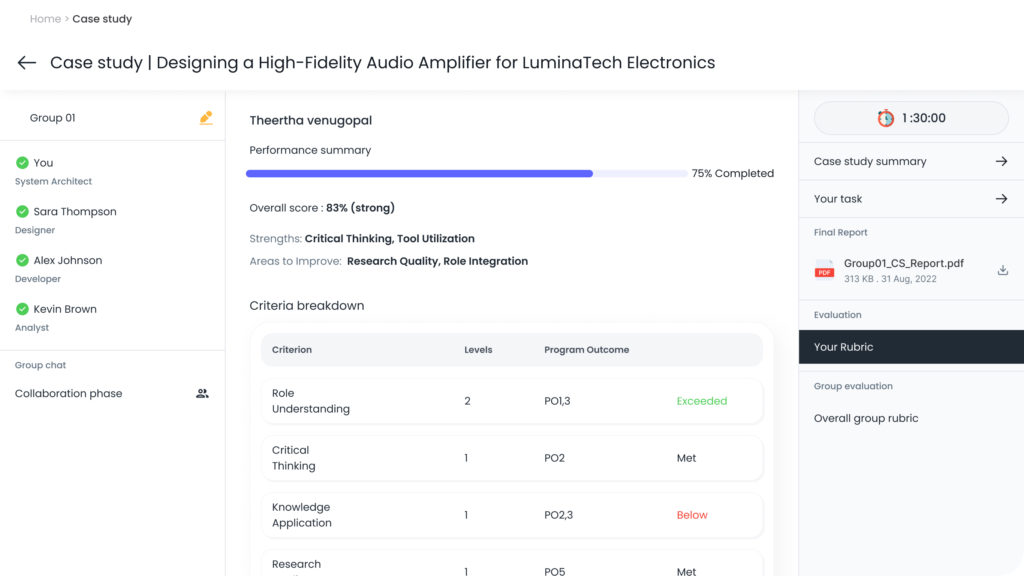
Here’s a scene playing out in engineering colleges across India right now: A professor finishes explaining a complex algorithm. Students nod, take notes, maybe even ace the exam. Three months later, they’re in an interview, faced with a real problem, and… freeze.
Not because they don’t know things. They know plenty; they can probably even ask ChatGPT to explain it better than the textbook did.
They freeze because knowing and doing are entirely different games. This is exactly why case-based learning is transforming engineering education: it teaches students to practice judgment, not just memorize answers
When Did We Start Teaching Students to Compete With Google?
There’s something deeply weird about our current moment in education. We have AI that can write code, explain concepts, solve equations, and generate reports (all in seconds). And yet, we’re still designing curricula around teaching students to… write code, explain concepts, solve equations, and generate reports.
It’s like training marathon runners exclusively by having them watch videos of other people running.
The uncomfortable truth? If your graduate’s main skill is “can solve problems that have clear right answers using established methods,” congratulations! You’ve just trained them to do exactly what AI does better, faster, and cheaper.
What Harvard Business School Figured Out 100 Years Ago
Here’s what’s interesting: Harvard Business School didn’t invent case-based learning almost a century ago because they were bored with lectures. They did it because they noticed something crucial: you can’t learn judgment from a textbook.
Should you launch this product now or wait six months? This design is technically superior, but costs 40% more. Which one do you recommend? Three stakeholders want three different things. How do you move forward?
These aren’t trick questions with hidden right answers. They’re judgment calls. And judgment develops the same way athletic skill develops: through repeated practice with feedback, not through reading about how other people did it.
The research backs this up beautifully, by the way. Students learning through case studies show significant improvements in critical thinking, problem-solving, communication, and teamwork. But more importantly, they actually enjoy learning more.
The Myth: Case-Based Learning Is Only for Management Students
We need to talk about this persistent idea that case-based learning is for the “soft skills” crowd.
Let me give you a real scenario: You’re designing a mobile app. You could use Framework A (fast development, but limited scalability) or Framework B (more robust, but steeper learning curve for your team). Your deadline is tight; your team is junior; your client keeps changing requirements.
What do you do?
This is an engineering problem. But the “right” answer depends on context, constraints, and trade-offs. It requires you to think like an engineer, communicate like a professional, and collaborate like a team member.
You know what doesn’t prepare you for this? Solving 50 textbook problems where someone already decided what the constraints are and what matters.
The Real Skills Gap
Walk into any hiring manager’s office and ask what they’re looking for. Nobody says “I need someone who memorized more algorithms.” They say things like:
“Can they break down a messy problem?”
“Will they work well with the team?”
“Can they explain technical decisions to non-technical stakeholders?”
“Do they ask good questions or just wait to be told what to do?”
These aren’t bonus skills. These are the job.
You don’t develop these by sitting in lectures; you develop them by working on problems that are messy, ambiguous, and require you to figure things out with other people. This is why only doing curriculum-prescribed projects isn’t enough. Real problems don’t come with starter code and a rubric.
Scaling Case-Based Learning Beyond Elite Institutions
Okay, so case-based learning is great. Everyone nods. Then someone points out: “But we have 200 students per class. How do we facilitate meaningful discussions for 40 groups simultaneously?”
This is a real problem. The Harvard model works partly because of intensive human facilitation: faculty who guide discussions, ensure everyone participates, probe weak arguments, and help students extract lessons.
You can’t just throw 40 groups into breakout rooms and hope for the best. Some groups will dominate with one loud voice. Others will go off track. Many will stay surface-level because nobody’s pushing them deeper.
So, elite institutions with great faculty-student ratios get to do this well. Everyone else… doesn’t.
This is exactly the problem we’ve been obsessing over at Edwisely: making case-based learning work at scale in engineering education.
Here’s our bet: AI doesn’t replace good teaching, but it can make good teaching accessible to far more students.
Imagine: Your students are working through a case study in groups. Each person has a specific role (one person focuses on identifying problems, another on researching solutions, another on evaluating trade-offs).
As they discuss, the system notices: This group hasn’t considered security implications. That person hasn’t contributed in 15 minutes. This group is stuck on a minor detail and missing the bigger picture.


Instead of a faculty member running between 40 groups trying to catch these moments, the system provides gentle nudges: “Have you considered security implications?” “What do you think about this, Priya?” “You’ve spent 20 minutes on this detail. What’s the core problem you’re solving?”
Not replacing human judgment. Scaffolding it. Creating a structure that lets more students experience guided collaborative problem-solving.
The gap between what colleges teach and what the workplace needs has always existed. But AI just made that gap exponentially more visible (and more urgent).
So What Should Colleges Actually Do?
If you’re running an engineering program and wondering, “Are we giving students repeated, structured opportunities to practice the kind of collaborative problem-solving they’ll actually do in their careers?” If the answer is no (or if it’s “yes, but only for our top students”), Edwisely can help you.
Case-based learning isn’t the only answer. But it’s one powerful approach to shifting from “content delivery” to “capability development.”
And here’s the thing: this isn’t optional anymore. Not because of educational theory, but because of basic economics. If your graduates’ main value proposition is “I can do things AI can do,” they’re going to struggle. If their value proposition is “I can navigate complex problems, work with diverse teams, and make sound judgments under uncertainty,” they’re going to thrive.
The difference? The second group practiced those skills dozens of times during college. The first group heard lectures about them.
The Invitation
At Edwisely, we’re not claiming to have all the answers. But we’re deeply committed to making rich, collaborative, problem-based learning accessible to every student, not just those at IITs or institutions with unlimited resources.
Here’s what we believe: Every student deserves the opportunity to develop professional competence through practice, not just theory.
That’s not just good pedagogy. In a world where AI has commoditized information retrieval and routine problem-solving, it’s an economic imperative.
Edwisely is building AI-powered intelligent learning infrastructures that brings structured, facilitated collaborative learning to institutions across India. Our recently published patent on case-based learning environments represents our commitment to educational equity: because every student, regardless of which college they attend, deserves to develop the skills that matter in the real world.

